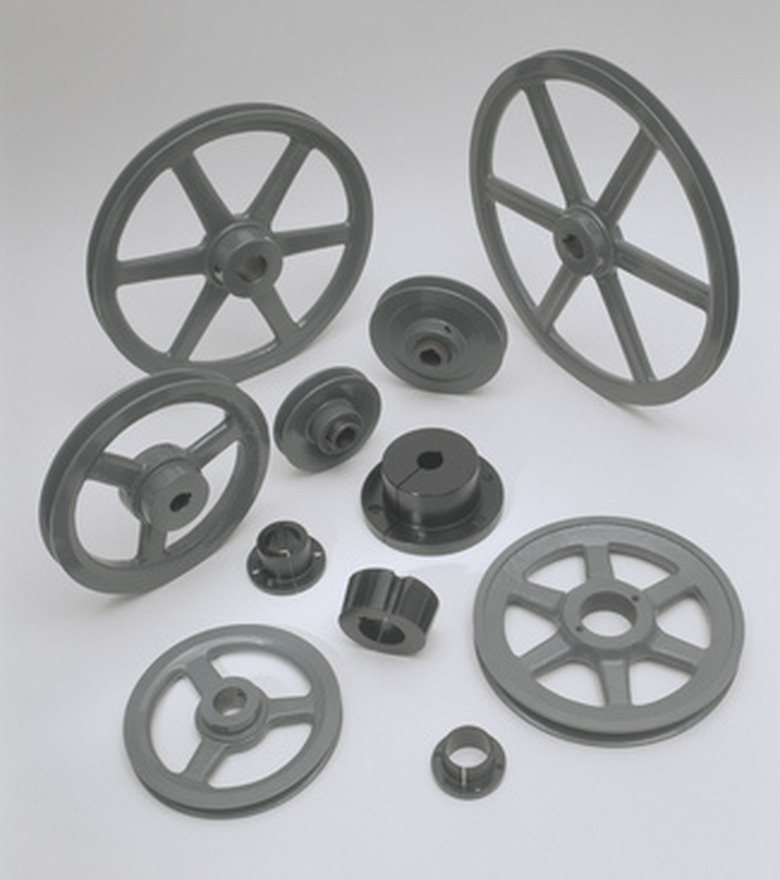How To Reduce RPMs Using Belts & Pulleys
The operation of shafts driven by electric or internal combustion motors or other forms of power is characterized by speed, torque and the location of the shaft. The load to be driven by the shaft will often require a different speed or torque or will require the transmission of power to an adjacent shaft. Reducing RPM can be accomplished by using two or more pulleys and belts to transmit and change the speed of rotation.
Step 1
Measure and note the key characteristics of the system. To design a pulley system to reduce the RPM of the power shaft, you will need the shaft speed, the diameter of the shaft, the distance of the power-shaft-center to load-shaft-center, the load shaft diameter and the required speed of the load shaft. If neither the power shaft nor the load shaft can be moved, you will need a tensioner pulley to keep the belt at the proper tension.
Step 2
Calculate the sizes of the pulleys. Get the speed ratio by dividing the speed in RPM of the power shaft by the speed in RPM of the load shaft. Assume a power shaft pulley size of 4 inches. This is generally a good size for efficient belt operation. Multiply by the speed ratio. The result will give the load shaft pulley size. A result less than twelve inches is acceptable. Otherwise, reduce the power shaft pulley size to 3 inches and repeat the calculation. Ideally, the power shaft pulley should be 3 inches or more and the load shaft pulley less than 12 inches. Other sizes are possible but a very small pulley on the power shaft is inefficient and causes higher wear due to the greater forces on a smaller diameter. A pulley larger than 12 inches is awkward to install but preferable to having a small pulley on the power shaft.
Step 3
Purchase and install the pulleys and the belt. If the speed of the load shaft is critical, purchase an adjustable pulley which is made from two halves, bolted together, and this will serve for the power shaft. When the bolts are tightened, the two halves are moved closer together and the effective diameter of the pulley is increased so that the speed can be adjusted slightly.
Make sure the pulleys are designed for the measured shaft diameters and then fix them on their respective shafts. Most shafts have a flat spot and the pulley can be fixed to the shaft by tightening a bolt so that the bolt sits on the flat spot.
Find the length of the belt. Calculate the circumference of each pulley by multiplying the diameter by 3.14. Add half of the diameter of each pulley to twice the shaft-center-to-shaft-center distance. Get the next larger standard size of belt.
Step 4
Install the belt on the pulleys and move the units apart until the belt has a slack of about 1/2 inch. The belt tension will have to be checked after about a day of continuous operation and again after about a week. The belt will stretch during this time and the units must be moved apart to compensate. If the units can't be moved, install a spring-loaded belt tensioner pulley anywhere on the belt between the two shafts. Position the pulley to give the required slack of about 1/2 inch. It will automatically keep the tension at the same level.
Cite This Article
MLA
Markgraf, Bert. "How To Reduce RPMs Using Belts & Pulleys" sciencing.com, https://www.sciencing.com/reduce-rpms-using-belts-pulleys-7901912/. 24 April 2017.
APA
Markgraf, Bert. (2017, April 24). How To Reduce RPMs Using Belts & Pulleys. sciencing.com. Retrieved from https://www.sciencing.com/reduce-rpms-using-belts-pulleys-7901912/
Chicago
Markgraf, Bert. How To Reduce RPMs Using Belts & Pulleys last modified March 24, 2022. https://www.sciencing.com/reduce-rpms-using-belts-pulleys-7901912/
